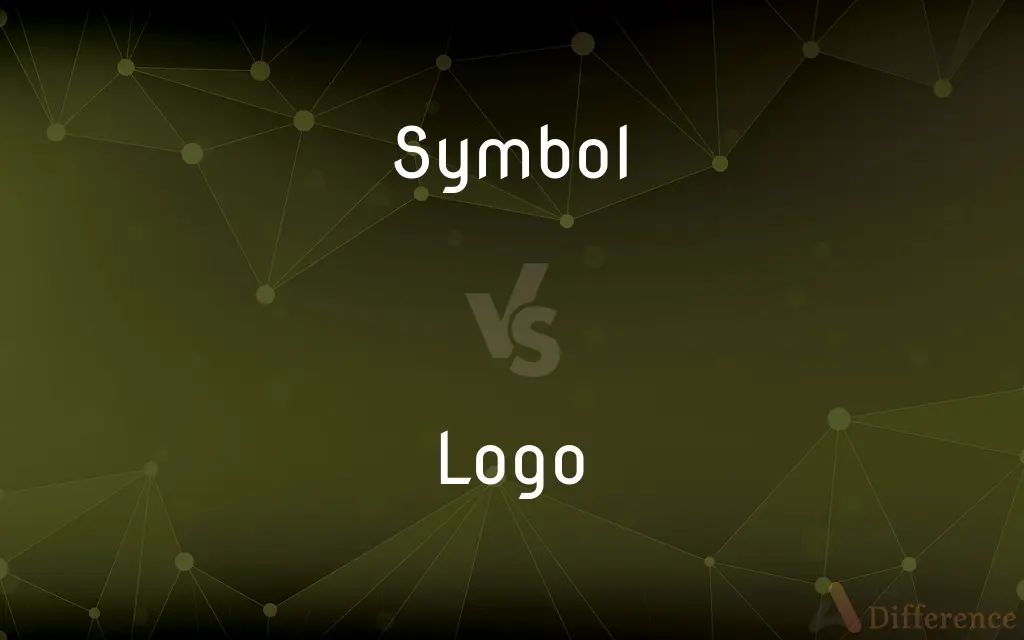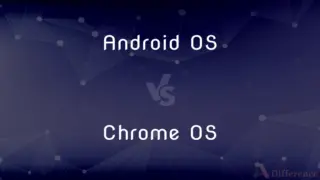Symbol vs. Logo — What's the Difference?
By Tayyaba Rehman — Updated on November 4, 2023
A symbol is a mark or sign that represents an idea, object, or relationship, while a logo is a designed emblem specific to a company or product for brand identity.

Difference Between Symbol and Logo
Table of Contents
ADVERTISEMENT
Key Differences
Symbols are foundational elements of communication, used to convey complex ideas, concepts, and philosophies through simple visual form. They are inherent in cultural, religious, and social contexts, often carrying historical significance. A logo, on the other hand, is a symbol created and used for a specific purpose by businesses and organizations to represent their brand identity.
Every culture is rich with symbols that encapsulate shared beliefs and values. The heart symbol, for example, is universally recognized as a representation of love. Logos, however, are unique to each company and are crafted to distinguish a brand from its competitors. For example, the golden arches are a logo that immediately identifies McDonald's.
Symbols often evoke emotional or philosophical responses and are open to interpretation. They can be abstract or representational and remain constant across various contexts. Logos are commercial in nature, designed to evoke recognition and specific attributes of a brand, such as reliability, innovation, or luxury.
The effectiveness of a symbol lies in its universal recognition and the depth of meaning it can communicate without words. Logos, conversely, aim to build a connection with consumers, becoming synonymous with the brand’s products or services over time through consistent marketing and brand presence.
Symbols can transcend language barriers, often without the need for translation. They are part of the collective unconscious, representing universal concepts like peace, danger, or access. Logos require strategic marketing to gain international recognition but can become so ingrained in a culture that they too can transcend language and become symbolic of certain lifestyles or values.
ADVERTISEMENT
Comparison Chart
Definition
A sign representing an idea, quality, or concept.
A graphical emblem designed for brand identification.
Function
Represents broader ideas or relationships.
Identifies and distinguishes a brand or product.
Context
Cultural, social, religious, universal.
Commercial, corporate, branding.
Interpretation
Can have multiple meanings, open to interpretation.
Intended for specific interpretation related to the brand.
Design Considerations
Aesthetics may be based on traditional or universal appeal.
Aesthetics are tailored to convey a brand's message and values.
Compare with Definitions
Symbol
An emblematic object or act that conveys a deeper meaning.
A ring is a symbol of eternal commitment in many cultures.
Logo
A graphic mark or emblem commonly used by enterprises and organizations for recognition.
The swoosh is the logo for Nike.
Symbol
A symbol is a mark, sign, or word that indicates, signifies, or is understood as representing an idea, object, or relationship. Symbols allow people to go beyond what is known or seen by creating linkages between otherwise very different concepts and experiences.
Logo
A custom-designed insignia for a company or product.
The four interlocking rings represent the logo of Audi.
Symbol
A mark or character used as a conventional representation of an object, function, or process, e.g. the letter or letters standing for a chemical element or a character in musical notation
The chemical symbol for helium is He
The symbol r in Figure 5 represents a gene which is ineffective
Logo
A symbol or small design adopted by an organization to identify its products, uniform, vehicles, etc.
The bitten apple is the logo of Apple Inc.
Symbol
A thing that represents or stands for something else, especially a material object representing something abstract
The limousine was another symbol of his wealth and authority
Logo
A distinctive feature or emblem that represents a company's brand or identity.
The blue bird is the logo of Twitter.
Symbol
Symbolize.
Logo
A logo (abbreviation of logotype, from Greek: λόγος, romanized: logos, lit. 'word' and Greek: τύπος, romanized: typos, lit. 'imprint') is a graphic mark, emblem, or symbol used to aid and promote public identification and recognition. It may be of an abstract or figurative design or include the text of the name it represents as in a wordmark.
Symbol
Something that represents something else by association, resemblance, or convention, especially a material object used to represent something invisible
The lamb is a symbol of innocence.
Logo
A symbol or other small design adopted by an organization to identify its products, uniform, vehicles, etc.
The Olympic logo was emblazoned across the tracksuits
Symbol
An instance that typifies a broader pattern or situation
His striking out to end the rally was a symbol of everything that had gone wrong with the team over the past month.
Logo
A symbol or design that identifies a brand.
Symbol
A printed or written sign used to represent an operation, element, quantity, quality, or relation, as in mathematics or music.
Logo
A visual symbol or emblem that acts as a trademark or a means of identification of a company or organization.
Symbol
(Psychology) An object or image that an individual unconsciously uses to represent repressed thoughts, feelings, or impulses
A phallic symbol.
Logo
(by extension) An audio recording for the same purpose; a jingle.
Symbol
A character or glyph representing an idea, concept or object.
$ is the symbol for dollars in the US and some other countries.
Chinese people use word symbols for writing.
Logo
(science) A single graphic which contains one or more separate elements.
Symbol
A thing considered the embodiment of a concept or object.
The lion is the symbol of courage; the lamb is the symbol of meekness or patience.
Logo
An ensign, a badge of office, rank, or power.
Symbol
(linguistics) A type of noun whereby the form refers to the same entity independently of the context; a symbol arbitrarily denotes a referent. See also icon and index.
Logo
A company emblem or device
Symbol
A summary of a dogmatic statement of faith.
The Apostles, Nicene Creed and the confessional books of Protestantism, such as the Augsburg Confession of Lutheranism are considered symbols.
Logo
A visual representation that encapsulates the identity of a brand.
The golden arches are the iconic logo of McDonald’s.
Symbol
(crystallography) The numerical expression which defines a plane's position relative to the assumed axes.
Symbol
(obsolete) That which is thrown into a common fund; hence, an appointed or accustomed duty.
Symbol
(obsolete) Share; allotment.
Symbol
(programming) An internal identifier used by a debugger to relate parts of the compiled program to the corresponding names in the source code.
Symbol
(telecommunications) A signalling event on a communications channel; a signal that cannot be further divided into meaningful information.
Symbol
To symbolize.
Symbol
A visible sign or representation of an idea; anything which suggests an idea or quality, or another thing, as by resemblance or by convention; an emblem; a representation; a type; a figure; as, the lion is the symbol of courage; the lamb is the symbol of meekness or patience.
A symbol is a sign included in the idea which it represents, e. g., an actual part chosen to represent the whole, or a lower form or species used as the representative of a higher in the same kind.
Symbol
Any character used to represent a quantity, an operation, a relation, or an abbreviation.
Symbol
An abstract or compendium of faith or doctrine; a creed, or a summary of the articles of religion.
Symbol
That which is thrown into a common fund; hence, an appointed or accustomed duty.
They do their work in the days of peace . . . and come to pay their symbol in a war or in a plague.
Symbol
Share; allotment.
The persons who are to be judged . . . shall all appear to receive their symbol.
Symbol
An abbreviation standing for the name of an element and consisting of the initial letter of the Latin or New Latin name, or sometimes of the initial letter with a following one; as, C for carbon, Na for sodium (Natrium), Fe for iron (Ferrum), Sn for tin (Stannum), Sb for antimony (Stibium), etc. See the list of names and symbols under Element.
Symbol
To symbolize.
Symbol
An arbitrary sign (written or printed) that has acquired a conventional significance
Symbol
Something visible that by association or convention represents something else that is invisible;
The eagle is a symbol of the United States
Symbol
A sign used to represent an idea, belief, or entity.
The dove is a symbol of peace.
Symbol
An element of a language or a system representing something abstract.
In mathematics, π is a symbol for the ratio of a circle’s circumference to its diameter.
Symbol
A mark or character used as a conventional representation of an object, function, or process.
The skull and crossbones symbol is often used to represent poison.
Symbol
Something that stands for or suggests something else by reason of relationship, association, or convention.
A red rose often serves as a symbol for love and romance.
Common Curiosities
Does a symbol have to be visual?
While symbols are often visual, they can also be expressed in other forms, like sounds or actions.
Can symbols be words?
Yes, words can function as symbols, representing ideas or objects beyond their literal meaning.
Do symbols change meaning over time?
Yes, the meanings of symbols can evolve with culture and context.
Are logos legally protected?
Logos can be trademarked, legally protecting them from unauthorized use.
What makes a logo effective?
An effective logo is distinctive, relevant, memorable, and adaptable.
Do logos need to include text?
Not necessarily, some logos are purely graphical, while others incorporate text.
Can a logo also be a symbol?
Yes, a logo can act as a symbol for a company or brand.
How are logos created?
Logos are created through a design process that considers the brand’s values, message, and target audience.
Are symbols universal?
Some symbols are nearly universal, while others have specific meanings in particular cultures.
Can symbols be offensive?
Certain symbols can be offensive or have negative connotations in some contexts.
How important is color in a logo?
Color is a crucial element in logo design, affecting perception and brand recognition.
Are all logos symbols?
All logos are symbols in the sense that they represent something larger, but not all symbols are logos.
Can a symbol belong to a specific group or culture?
Absolutely, many symbols are specific to particular cultures or groups.
Why do companies change their logos?
Companies may change their logos to update their image, signify a new era, or rebrand.
Can anyone create a symbol?
Yes, individuals or groups can create symbols to represent whatever they choose.
Share Your Discovery

Previous Comparison
Mercantile vs. Merchant
Next Comparison
Gyrocompass vs. CompassAuthor Spotlight
Written by
Tayyaba RehmanTayyaba Rehman is a distinguished writer, currently serving as a primary contributor to askdifference.com. As a researcher in semantics and etymology, Tayyaba's passion for the complexity of languages and their distinctions has found a perfect home on the platform. Tayyaba delves into the intricacies of language, distinguishing between commonly confused words and phrases, thereby providing clarity for readers worldwide.















































